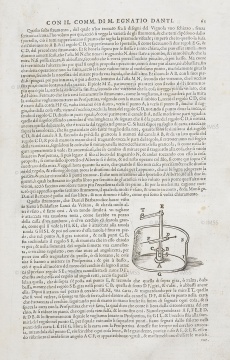Surveying Instrument by Baldassarre Lanci
From Inventions
Has no specific name.
Contents |
Inventor
Baldassarre Lanci (1510-1571)
Historic Period
1557
Description
Instrument invented and constructed by the engineer from Urbino Baldassarre Lanci, formerly part of the Medicean collection of scientific instruments and now at the Museo di Storia della Scienza di Firenze. It is a brass disk, richly decorated, carrying a compass, degree scale, shadow square and two graduated arms each with a sight hinged to the ends of a base marked with the same graduation. The shadow square was used to calculate distances and heights (in the latter case the disk was held in the vertical position). The degree scale with indication of the winds and division into 45° sectors, served to measure position angles. The two graduated arms were used to measure distances and heights, allowing a corographic map to be compiled by a method similar to that of the archimeter. The operation requires two known stations whose distance is proportional to the base divided into 200 parts, from which pivot the arms (divided into 400 parts). After the chosen point had been sighted from the first station and one of the arms had been fixed in the direction of the visual ray, the instrument was brought to the second station to perform the second sighting, causing the other arm to intersect the first one. The arms scale immediately shows the distance of the place observed, while at the same time the intersection point represents the planimetric position of that place (for compiling a chart of the territory) in relation to the surveying stations. The instrument is also equipped with a revolving rod, bearing a small telescope and a sliding pin, vertically directional, which can be used to draw a perspective view on the surface of a half cylinder mounted on a sector of the circumference. From this operation, the true-form layout of the object portrayed, for instance a fortress, could be determined. This operation is reported by D. Barbaro (1569, IX, IV) and E. Danti (1583, Le due regole [The two rules] I, III) who describe only the perspective function: "Baldessara Lanci ingenious engineer, showed me, while I was in Siena, an instrument designed by him to put [objects] in Perspective..." (Barbaro, IX. IV); "And for the same reason I will show here this seventh instrument, which is used by many, and held in esteem, and is placed by Monsign. Daniel Barbaro in his book, and nevertheless it is false, as can clearly be seen below. This instrument that Daniel Barbaro claims to have seen in Siena at the home of Baldassare Lanci from Urbino, and which is used by many others, is made like this " (Danti, I, III, p. 61).
Bibliographical Resources
Barbaro, Daniele. "La pratica della perspettiva di monsignor Daniel Barbaro ...: opera molto utile a pittori, a scultori et ad architetti: con due tavole, una de' capitoli principali, l'altra delle cose più notabili contenute nella presente opera". In Venetia, appresso Camillo & Rutilio Borgominieri fratelli, 1569, IX, IV Biblioteca Digitale.
Camerota, Filippo. "Il distanziometro di Baldassarre Lanci: prospettiva e cartografia militare alla corte dei Medici", in "Musa musaei: studies on scientific instruments and collections in honour of Mara Miniati". A cura di Marco Beretta, Paolo Galluzzi, Carlo Triarico, Firenze, L.S. Olschki, 2003, p. 79-92 Biblioteca Digitale.
Vignola, Giacomo Barozzi detto il. Le due regole della prospettiva pratica di m. Iacomo Barozzi da Vignola con i comentarij del R.P.M. Egnatio Danti. In Roma, per Francesco Zannetti, 1583, I, III.
Vignola, Giacomo Barozzi detto il. Le due regole della prospettiva prattica". Con i commentari del ... maestro Egnatio Danti. In Bologna, per Gioseffo Longhi, 1682. Biblioteca Digitale
Existing Instruments
- Museo Galileo, Institute and Museum of the History of Science, Florence
Firenze, Museo Galileo. Istituto e Museo di Storia della Scienza, Inv. 152, 3165.
Links (External)
http://www.mhs.ox.ac.uk/epact/maker.php?MakerID=24 (english)
Images
Author of the entry: Filippo Camerota

